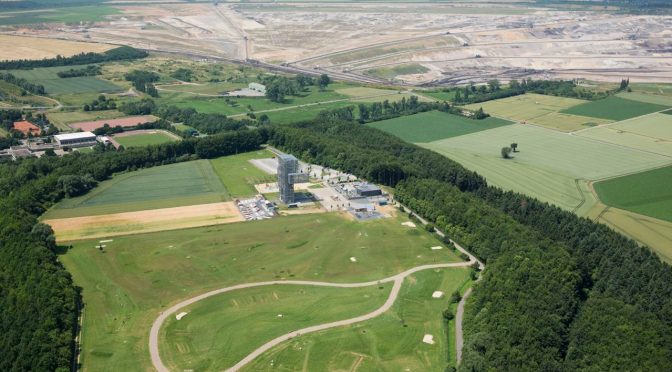It is still a gravel surface on the western edge of the Tagebau Inden open-cast mine. When it is terminated at the end of 2029, this strip of land will become the banks of a lake. But it will be two decades before the first waves hit the shore – time enough to turn the area into a large solar farm with battery storage in the meantime. That is exactly what RWE proposed in its winning bid to the Federal Network Agency’s innovation tender.
Some specifics: The federal authority called for bids for a total of 250 megawatts with the aim of enabling particularly ambitious renewables projects to be carried out. RWE was successful at this tender: The Federal Network Agency granted RWE a fixed market premium on the solar electricity generated on the banks of Inden lake. Now the company will call for quotes for the different components of the planned plant and apply to the Kreis Düren district authority for a building permit. If all goes well, construction could begin in October. In June 2022 the project would then generate and store its first electricity.
The solar modules will be designed to have a peak availability of 14.4 megawatts of electric output. The battery storage system connected to the modules will be designed for a two-hour electricity input and output of a total of 9.6 megawatt hours. This means it will serve as a buffer between solar electricity generation and the supply network so that the power feed-in can be even better matched to demand. The plant at the future lake will be called “PV Hybrid Inden” and will be the first of its kind in RWE’s European portfolio.
Katja Wünschel, COO Wind Onshore & Solar PV Europe & APAC at RWE Renewables: “With the combination of photovoltaics and storage technology in one commercial system, we are setting a key milestone as a plant operator in Germany and are gaining valuable experience for the expansion of renewable energies. The future belongs to hybrid technologies, also in the area of renewables. Those who take the initiative here and are successful will play a part in making the energy transition a success.”
Dr Lars Kulik, the Executive Board member with responsibility for lignite at open-cast mine operator RWE Power: “It absolutely makes sense to use temporarily dormant former mining surfaces for solar plants. Our recultivation project offers plenty of space for renewables – to ensure that the region remains an energy producer in the future and the structural transformation is successful.”
RWE already operates the indeland-Windpark Eschweiler wind farm very close to the plant’s solar location; this is also a collaboration project with regional partners such as the Königshovener Höhe and Jüchen A 44n wind farms on the edge of the Tagebau Garzweiler opencast mine. Overall, RWE already operates wind farms in the Rhenish mining region with a capacity of over 300 megawatts. RWE is also continuously expanding its international onshore wind portfolio of over six gigawatts. Besides in its home market Germany, the company is also currently constructing onshore wind farms in the US, the Netherlands, Poland, Sweden, Italy and in Great Britain. RWE operates two biogas plants with a total of some eight megawatts of thermal output in Bergheim-Paffendorf and at Kraftwerk Neurath (Grevenbroich) power plant.
RWE was also successful with a solar project in Rhineland-Palatinate in the most recent tender by the Federal Network Agency: a photovoltaic plant with an installed capacity of 2.4 MWp is to be built in the municipality of Seesbach (Bad Kreuznach district).


